CIRCLE TIME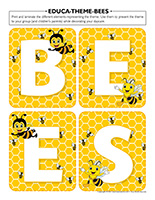
Poni discovers and presents-Bees
(Open Poni discovers and presents-Bees) Print, cut out, and laminate the pictures. Present the pictures to your group. If you have a Poni puppet, use it to make your presentation attractive for little ones.
Educa-circle time-Bees
(Open educa-circle time-Bees) (Open giant word flashcards-Bees) Print the questions and the giant word flashcards. Laminate them. Deposit the questions in a box and encourage children to take turns picking one. Spread the giant word flashcards out on a table or display them on a wall. Also print the "It's my turn" card. Laminate it and glue a Popsicle stick behind it. It will help children respect the child whose turn it is to speak throughout this activity. The questions will help little ones develop their sense of observation, their vocabulary, and cooperation skills while providing them with the opportunity to practice waiting for their turn. This tool will help you organize a group discussion about the theme.
Questions for circle time:
- Have you ever seen a bee?
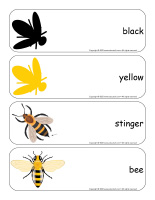
- What do you think is special about bees?
- Can you name other insects that sting?
- Have you ever been stung by a bee or another insect?
- Which colors can be seen on a bee's body?
- What do bees make?
- Have you ever eaten honey?
- Is honey sweet or salty?
AREA SETUP
Thematic poster-Bees
(Open thematic poster-Bees) Print, laminate, and display where children (and parents) are sure to see it.
Educa-decorate-Bees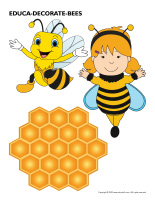
(Open educa-decorate-Bees) Print, laminate, and cut out the illustrations. Use them to decorate your walls and set the mood for the theme.
Stickers-Bees
(Open stickers-Bees) Print the illustrations on adhesive paper and use them to create a collection of unique stickers. Use them to reward children throughout the theme.
Educa-theme-Bees
(Open educa-theme-Bees) Print and laminate the different elements representing the theme. Use them to present the theme to your group (and children’s parents) while decorating your daycare.
Door decorations-Bees
(Open door decorations-Bees) Print, laminate, and cut out the items. Use them to decorate your daycare doors to set the mood for the theme.
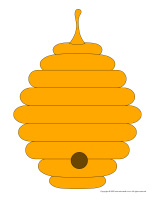
Educa-numbers-Bees
(Open educa-numbers-Bees) Print and laminate the posters. Display them on a wall to decorate your daycare throughout the theme.
Educa-letters-Bees
(Open educa-letters-Bees) Print and laminate the posters. Display them on a wall to decorate your daycare throughout the theme.
Garland-Bees
(Open garland-Bees) Print and have children decorate the items. Cut them out and hang them in your daycare to create a garland.
PICTURE GAME
The pictures may be used as a memory game or to spark a conversation with the group. Use them to decorate the daycare or a specific thematic corner. (Open picture game-Bees) Print, laminate, and store in a “Ziploc” bag or in your thematic bins.
Memory game-bees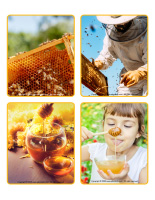
(Open picture game-Bees) Print the pictures twice and use them for a memory game.
ACTIVITY SHEETS
Activity sheets are provided for each theme. Print and follow instructions. (Open activity sheets-Bees)
WRITING ACTIVITIES
Writing activity-B like Bee
(Open writing activities-B like bee) Print for each child or laminate for use with a dry-erase marker.
Stationery-Bees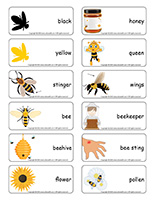
(Open stationery-Bees) Print. Use the stationery to communicate with parents, in your writing corner, or to identify your thematic bins.
Educa-nuudles-Bees
(Open educa-nuudles-Bees) Print for each child. Have children color the sheet. Once they are done, they may use Magic Nuudles to turn the coloring pages into three-dimensional works of art. Variation: If you do not have Magic Nuudles, ask children to fill the spaces designed for the Magic Nuudles with bingo markers or stickers. To order Magic Nuudles: MAGIC NUUDLES - Educatall Online Store (educatout.com)
LANGUAGE ACTIVITIES
The flashcards may be used during circle time to spark a conversation with the group or in your reading and writing area. They may also be used to identify your thematic bins. (Open word flashcards-Bees) (Open giant word flashcards-Bees) black, yellow, stinger, bee, beehive, flower, honey, queen, wings, beekeeper, bee sting, pollen
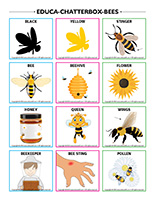
Let’s chat
Print and laminate the word flashcards. Have each child pick a word. They can take turns presenting their word to the group. Ask children questions to encourage them to share what they know about items related to the theme.
Educa-chatterbox-Bees
(Open educa-chatterbox-Bees) Print and laminate the cards. To create your chatterbox, you will need an empty shoebox or a small bin that you can decorate as you see fit. Fill it with tiny objects, illustrations, pictures, and accessories related to your theme. To help you, we have created a series of cards that you may use. During circle time or, for example, when children are waiting for their lunch, have them take turns picking a card or object out of your chatterbox and naming the corresponding item.
Beehive scene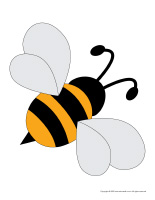
(Open scene-Beehive) Print, laminate, and cut out. Children use the items to complete the scene.
VARIOUS WORKSHOS-Insects
Construction/building blocks:
- Green straw (from Easter baskets) in a shallow container and plastic insects children can play with.
- Offer only green, black, brown, and red blocks and encourage children to create giant insects.
- Assembly games (K-Nex or Magnetix) that children can use to imagine both scary and silly insects.
- Drinking straws that can be inserted one inside the other to create the longest worm possible! If you wish, you can organize a contest among the children in your group or several daycare groups.
Arts & crafts: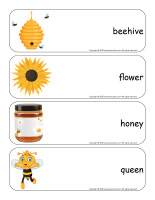
- Plastic insects and poster paint. Have children dip the insects in the paint and then make them walk on a piece of paper to create prints.
- Attach plastic (or jelly) worms to the end of a fishing rod and dip them in paint and then press them on paper to create unique prints.
- Make insect crowns! Simply use a strip of paper and antennae and you're set! Use red and black to make ladybug crowns or black and yellow to make bee crowns.
- Empty toilet paper rolls, cardboard wings, pipe cleaner antennae, and a little paint are all you need to create bees or butterflies.
- A clothespin attached to the centre of a coffee filter is perfect for creating a butterfly or a dragonfly. Add a few drops of food coloring for a touch of color.
- A butterfly model can be covered with pieces of colourful tissue paper.
- Cut a paper plate in half and reattach the halves using a fastener. Paint these wings with red and black paint to make an adorable ladybug.
- Two egg carton sections, two wiggly eyes, black and yellow paint, cardboard or tulle wings, and antennae for making a bumblebee.
- Insect-shaped paper punches.
- Honeycomb cereal for a special beehive collage.
- Pieces of brown, pink, and black yarn to represent worms.
- Use glow-in-the-dark paint to create fireflies.
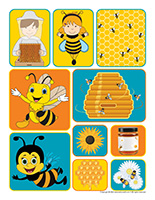
- Use two empty toilet paper rolls to make binoculars.
- Use string and poster paint for "worm painting"
- Use a series of egg carton sections to make a caterpillar.
- Blow through a drinking straw onto a large drop of brown or black poster paint to create a spider.
Drawing:
- Insect, flower, and garden-related stencils.
- Insect coloring pages.
Role play:
- Set up a beekeeper area complete with a beekeeper hat, a rain suit, plastic bees, a large square box (to represent a beehive), and a few instruments and tools (watering can, shovel, etc.).
- Organize an insect hunter area that includes butterfly nets, containers that can be used to capture insects, plastic insects of all kinds, binoculars, index cards with the description of different types of insects, magnifying glasses, etc. Decorate the area with pictures of insects. You can also prepare a picnic lunch. After all, insects are always eager to attend picnics!
- Set up a gardening area with various gardening accessories (toy versions), watering cans, empty flower pots, etc. Also add gloves, sun hats, a hose, and knee protectors.
- Dress up like insects.
Manipulation: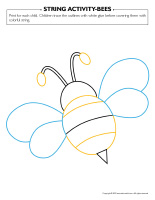
- Memory game with insect illustrations (educatall picture game).
- Insect puzzles (homemade or store-bought).
- Modeling dough with plastic insects that can be pricked in the dough. Add flower-shaped cookie cutters. Children will love to make the plastic insects land on the flowers to help them collect nectar.
- Real insects captured in transparent containers.
- Association game involving insects (insects that sting, crawl, fly, etc.).
- Several illustrations of insects that have spots on their back. Children must sort them according to the number of spots they have.
- Association game involving flowers and insects of the same color.
Pre-reading:
- Books about insects and flowers.
- Colourful butterfly pictures to decorate the walls of your area.
Pre-writing:
- Connect the dot insect activity sheets.
- Insect illustrations that can be compared to find the differences.
- Hunt and seek activities.
- Insect activity sheets.
- Games involving educatall word flashcards.
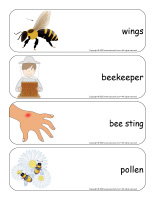
Motor skills:
- Have children pretend they are worms crawling on the ground.
- Obstacle course that includes chairs children must crawl under like ants in their anthill.
- Simon says...to act like different types of insects.
- Treasure hunt.
- Set a jumping rope on the floor to represent a worm and encourage children to walk on it.
- Wave a jumping rope back and forth just above the floor and encourage children to jump over it without touching it.
- Pretend to fly around the daycare like an insect.
- Pin the stinger on the insect. Display a large bee illustration on a wall and encourage children to try to stick the stinger as close to the right spot as possible while blindfolded.
- Have children sit in a circle and toss a ball of yarn back and forth to create a giant spider web.
Sensory bins: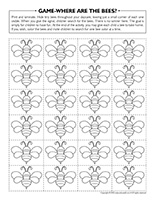
- Fill a container with soil and add real worms.
- Hide plastic insects in your sandbox or sand table.
- Fill a large container with Honeycomb cereal.
- Add lily pads and plastic insects to your water table.
Early science:
- Create your own vivarium in an empty aquarium or give each child a clear plastic container so they can make their own. Add dirt, grass, and any insects they find while playing outdoors. Don't forget to cover children's vivarium(s) with a screen.
ROUTINES AND TRANSITIONS
Game-This is my spot-Bees
(Open game-This is my spot-Bees) Print two copies of each illustration. Use adhesive paper to stick one copy of each illustration on the table. Place the second copy in a bag. Children take turns picking an illustration to determine where they must sit at the table. You may also use the illustrations to determine children's naptime spots or their place in the task train.
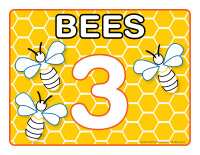
My bee path
(Open my bee path) Print, laminate, and secure the illustrations on the floor of your daycare to create a path leading to the areas frequently visited by children throughout the day. The path can lead to the bathroom, the cloakroom, etc. If you prefer, use the illustrations to delimit various areas.
ACTIVITIES FOR BABIES
Yellow
Fill a large container with yellow objects and toys. Let babies explore the contents of the bin to discover this color. Name the color often during their exploration.
I see yellow!
Fill clear plastic bottles with a variety of yellow items (feathers, marbles, beads, paperclips, etc.) or a mixture of water and yellow food coloring. Seal the caps with hot glue.
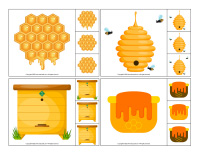
Insect bottles
Collect several clear plastic bottles and containers (mayonnaise, peanut butter, juice, dressing, etc.). Add items found in nature and plastic insects to each bottle. If you wish, you can add spiders to one bottle, flies to another bottle, etc. Seal the caps with hot glue.
PHYSICAL ACTIVITY AND MOTOR SKILLS
Modeling dough activity placemats-Bees
(Open modeling dough activity placemats-Bees) Print and laminate. Let children pick a placemat and provide modeling dough. Encourage them to use the dough to fill or reproduce the shapes that are on their placemat.
Educ-clothespins-Bees
(Open educ-clothespins-Bees) Print and laminate. Children must find and identify the matching illustration using a clothespin.
String activities-Bees
(Open string activities-Bees) Print for each child. Children trace the outlines with white glue before covering them with colorful string.
Flying bees
Inflate 4 or 5 yellow balloons. Tell children that they must never touch the floor. If you wish, you can give children more complex instructions. For example, you can ask them to not touch the balloons with their hands, to blow on them, etc.
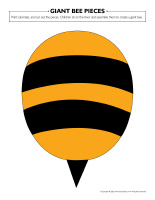
Lacing-Bees
(Open lacing-Bees) Print, laminate, and make holes around the contour of each shape. Children can use string or shoelaces to lace the shapes.
Punch holes around the contour of a yellow paper plate. Have children add eyes, a nose, a mouth, and antennas. Give each child a long piece of black yarn that they can thread through the holes, moving from side to side to draw stripes.
Beehives
Set different sizes of boxes on the floor to represent beehives. Let children play in them.
Bee-themed obstacle course
Close your daycare curtains and lights and create an obstacle course that children can complete in the dark. Hang glowsticks along the course and encourage children to collect them. Once they have all completed the course, have them connect the glowsticks to create a circle of light. Use glowstick bracelets for this activity.
Game-The beehive and the bees
(Open game-The beehive and the bees) Print, laminate, and cut out the beehive. Press it on a wall. Give each child a laminated bee. They can take turns trying to press it as close to the beehive as possible, while blindfolded.
Giant bee pieces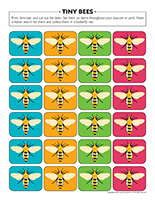
(Open giant bee pieces) Print, laminate, and cut out the pieces. Children sit on the floor and assemble them to create a giant bee.
Game-Where are the bees?
(Open game-Where are the bees) Print and laminate. Hide tiny bees throughout your daycare, leaving just a small corner of each one visible. When you give the signal, children search for the bees. There is no winner here. The goal is simply for children to have fun. At the end of the activity, you may give each child a bee to take home. If you wish, color the bees and invite children to search for one bee color at a time.
Beware of the queen bee
Pick a child who shall be the queen bee. The queen bee chases the other children. When a child is touched by the queen bee, he becomes the queen bee. Variation: Have children who are touched by the queen bee stop in their tracks and stand with their arms out to their sides until one of their peers runs under one of their arms to “free” them.
Bee hunt
(Open tiny bees) Print, laminate, and cut out the bees. Set them on items throughout your daycare or yard. Have children search for them and collect them in a butterfly net.
Bee dance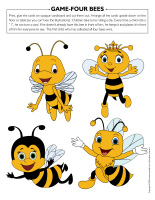
Bees dance to communicate. Encourage children to dance, without music at first, to express their emotions. They can, for example, hop around and move quickly if they are happy or dance slowly if they are sad. After a while, play fast-paced music and invite children to dance to the beat.
Beehive cleanup
Explain how bees like to live in a clean environment and hate dust. Move furniture around to create a large empty space and divide this area to represent two beehives using adhesive tape. Divide your group into two teams. Collect several soft objects (foam balls, scarves, stuffed animals, socks, etc.) and scatter an equal number of objects in each beehive. When you give the signal, both teams have 2 minutes to clean their beehive, tossing (or sliding) the items into the other team’s beehive. When the time is up, count the objects in each beehive to determine the winning team.
Bees collect pollen
(Open game-Bees) Print and laminate the illustrations for durable, eco-friendly use. Before beginning, hide the flowers in your yard. Give each child one bee. When you give the signal, children must search for the ten (10) flowers that correspond to their bee's color and deposit them in a predetermined container or area. This game can also be done indoors.
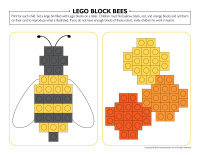
Beehive
Children stand in a circle around you. With your arm, indicate a direction. Children must move in the corresponding direction. Change direction several times. After a while, shout "beehive!" Children must quickly stand as close together as possible. Continue the game alternating directions and saying "beehive!"
COGNITIVE ACTIVITIES
Lego block bees
(Open lego block bees) Print for each child. Set a large bin filled with Lego blocks on a table. Children must find yellow, black, red, and orange blocks and set them on their card to reproduce what is illustrated. If you do not have enough blocks of these colors, invite children to work in teams.
Educa-dots-Bees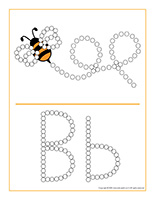
(Open educa-dots-Bees) Print for each child. Give each child a small bowl filled with poster paint and a cotton swab. They must dip their cotton swab in the paint and then on each dot on their sheet to represent shapes or letters. Let dry. Display their work on a bulletin board. Have fun naming the letters and items with your group.
Game-Four bees
(Open game-Four bees) Print, glue the cards on opaque cardboard and cut them out. Arrange all the cards upside down on the floor or table (so you can’t see the illustrations). Children take turns rolling a die. Every time a child rolls a “1”, he can turn a card. If he doesn’t already have this bee in front of him, he keeps it and places it in front of him for everyone to see. The first child who has collected all four bees wins.
Counting cards-Bees
(Open counting cards-Bees) Print and laminate. Prepare a series of wooden clothespins on which you can paint or draw numbers 1 to 9. Children count the items on each card and place the corresponding clothespin on the correct number.
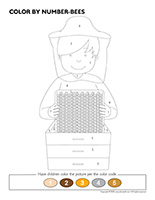
Color by number-Bees
(Open color by number-Bees) Print for each child. Have children color the picture per the color code.
Snakes and ladders-Bees
(Open snakes and ladders-Bees) Print and laminate. Use a die and tiny plastic insects as playing pieces.
Coloring hunt and seek-Bees
(Open coloring hunt and seek-Bees) Print and laminate. Children must find and color the items.
Homemade wooden puzzles
Print pictures of bees and color them if necessary. Press several Popsicle sticks together and glue a picture on top of them. Cut around each stick and set them in a Ziploc bag. Repeat with the other pictures. Children will enjoy placing the sticks in the correct order to see bees appear.
Educ-differences-Bees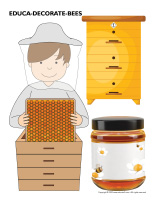
(Open educ-differences-Bees) Print and laminate for durable, eco-friendly use. Children must find the differences between the two pictures and identify them using a dry-erase marker.
Educ-trace-Bees
(Open educ-trace-Bees) Print for each child. Children must trace the dotted lines using a crayon of the corresponding color and then color each object using the same color.
Educ-math-Bees
(Open educ-math-Bees) Print and laminate for durable, eco-friendly use. Children must count the items in each rectangle and circle the corresponding number.
Hunt and seek-Insects
(Open hunt and seek-Insects) Print and laminate. Children pick a card and search for the item in the scene.
MORAL AND SOCIAL ACTIVITIES
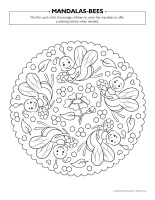
Dress-up dolls-Bees
(Open dress-up dolls-Bees) Print and laminate. Children will love to dress the doll.
Thematic box: Insect hunter. Fill a box with the following items: a net for catching insects, clear plastic containers, tweezers, magnifying glasses, plastic insects, a microscope, binoculars, a vivarium, a beekeeper hat, an empty bottle of bug repellant, etc.
Bee face painting
Paint bee antennae and black and yellow stripes on each child’s face and encourage them to admire their reflection in a mirror.
Mandalas-Bees
(Open mandalas-Bees) Print for each child. Encourage children to color the mandalas to offer a relaxing activity when needed.
Group project-Bees
Draw a giant bee outline and hang it on a wall. Provide a wide range of arts & crafts materials and encourage children to work together to decorate the bee.
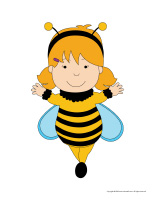
Rearranging my area
Let children pick new naptime spots. Take advantage of this change to discuss how bees build their beehive.
You are stung...go to sleep
Before naptime, tell children you have captured a special kind of bee. When it stings, children fall asleep. Invite children to close their eyes. Go from one child to the next buzzing like a bee and touching them with your index finger to "sting" them. Older children may call your bluff, but you can simply tell them that they don't fall asleep as quickly because they are older. Little ones will fall for it every time.
EARLY SCIENCE/MANIPULATION/EXPLORATION
A real beehive
Ask around and try to find a beekeeper that could lend you an empty beehive children could explore and manipulate. You may also purchase real honeycombs. Children will enjoy using a magnifying glass to study them up close. If you wish, they may even taste the honey!
Insect lab
You will need clear containers, magnifying glasses, tweezers, pieces of tulle or screen, and pictures of different types of insects found in nature. Encourage children to capture insects, compare them to find differences and similarities, etc.
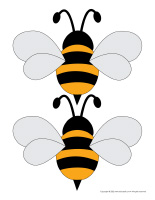
Exploring yellow
Organize a workshop in which children can mix yellow paint with other colors to observe color changes. If you prefer, you may also use a mixture of water and food coloring.
CULINARY ACTIVITIES
Yummy honey!
Serve a variety of food items related to the theme: different honey flavours, beeswax, royal jelly, etc.
Eating like bees
Explain how bees use their proboscis (a small tube) to eat. Serve liquid foods children can eat through a straw such as soup, smoothies, or yogurt drinks. They can eat their main course with their stinger (fork).
Honeycomb cereal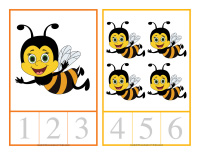
Serve Honeycomb cereal with a glass of milk as a snack.
Honey banana
Give each child half of a banana with a Popsicle stick inserted in one end to make manipulations easier for little hands. Have children dip their banana in honey and then in cereal (Rice Krispies, Corn Flakes, etc.).
ARTS & CRAFTS
Puppets-Bees
(Open puppets-Bees) Print the models on heavy cardboard. Have children cut them out and decorate them with a variety of materials. Glue a Popsicle stick behind each model to create puppets.
Models-Bees
(Open models-Bees) Print the models and use them for various crafts and activities throughout the theme.
Stencils-Bees
(Open stencils-Bees) Print and cut out the different shapes. Children can use them to trace or paint items related to the theme.
Egg bee
Have children paint a Styrofoam egg with yellow poster paint. Once the eggs are dry, help them wrap a black pipe cleaner around their egg to represent bee stripes. Add two tiny pipe cleaner pieces for the antennae and two wiggly eyes to complete their bee. Hang the bees from the ceiling.

Textured beehive
You will need several empty toilet paper rolls for this craft (9 per child). Have children paint the rolls with yellow paint. Once dry, help them assemble them to represent a honeycomb. If you wish, you can glue small construction paper bees inside the sections.
Textured wrapping paper
(Open hexagon shape) Print and have children cut out the hexagon. You will need bubble wrap for this activity. Have children paint the bubble wrap with yellow poster paint and press the hexagons on top to create honeycombs.
Bees in my beehive
(Open models-beehives) Print a beehive for each child or glue several beehives on a large piece of cardboard for a group project. Encourage children to press their finger in yellow poster paint and then on the paper to represent bees. Once the paint is dry, add antennae, wings, and black stripes using a marker.
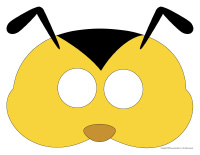
Beehive
On a piece of cardboard, draw a large beehive. Have children glue Honeycomb cereal inside the shape.
Bee
Have each child draw and cut out a bee outline. Provide small pieces of yellow and black paper and encourage them to cut strips of each color they can stick on the shape.
My bee hat
(Open educa-decorate-Bees) Print and cut out the items. Have children glue them on a paper headband.
Masks-Bees
(Open masks-Bees) Print and set the documents in the center of a table. Let children create unique bee masks using a variety of arts & crafts materials. Use string to tie each child’s mask behind his head.
Crafts-Bees
(Open models-Bees) Print the models and use them for various activities and creations throughout the theme.
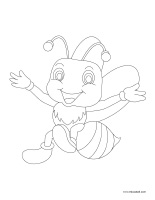
Modeling dough bees
Prepare yellow homemade modeling dough. Encourage children to use it to create bees. You may add brown or black rice to your dough to create an interesting texture. Children can press wiggly eyes in the dough to complete their bee.
My bee book
Cut pictures related to the theme out of magazines, old books, etc. Glue them on 10 cm x 13 cm pieces of paper and insert 2 pieces back-to-back in several Ziploc bags. Staple the bags together at the closed end so that you can open the bags if necessary. Use colorful adhesive tape to cover the staples.
COLORING PAGES
(Open coloring pages theme-Bees) Print for each child.
Identical coloring pages-Bees
Print the same coloring page for each child and an additional copy for your model. Color only certain parts of your picture. Present the model to your group and ask them to color their picture to make it look exactly like yours.
Coloring binder-Bees
Print and laminate several coloring pages and arrange them in a binder with a few dry-erase markers. Leave everything on a table for children to explore.
Musical drawing-Bees
Play musical drawing with your group. Give each child a coloring page. Have children sit around a table. When the music starts, they must pass the coloring pages around the table. Every time the music stops, they must color the picture in front of them until the music starts again.
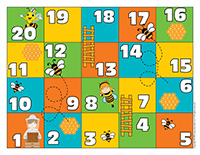
Homemade puzzles-Bees
Give each child a picture to color. When they are done, cut each picture into pieces to create unique puzzles.
CREATIVE COLORING
(Open creative coloring-Bees) Print for each child. Have children complete the drawing.
Complete the drawing-Bees
(Open complete the drawing-Bees) Print for each child. Have children complete the picture by drawing the missing elements.
I am learning to draw-A bee
(Open I am learning to draw-A bee) Print and laminate the model sheet. Encourage children to practice their drawing technique on the model sheet before trying to draw a bee on their own.
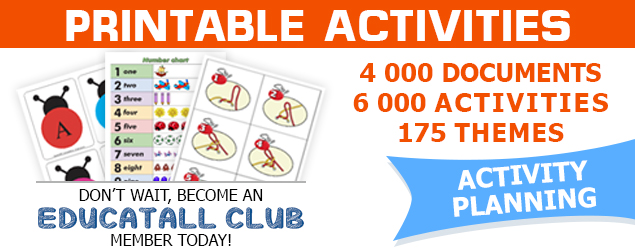
 Home
Home Theme activities
Theme activities
 Babies and toddlers
Babies and toddlers
 Arts and crafts
Arts and crafts
 Science
Science
 Creative recipes
Creative recipes
 Tips and tricks
Tips and tricks
 Special needs
Special needs
 Extra activities
Extra activities
 Educ-TV
Educ-TV
 Newsletter
Newsletter  Online store
Online store Educatall club
Educatall club

